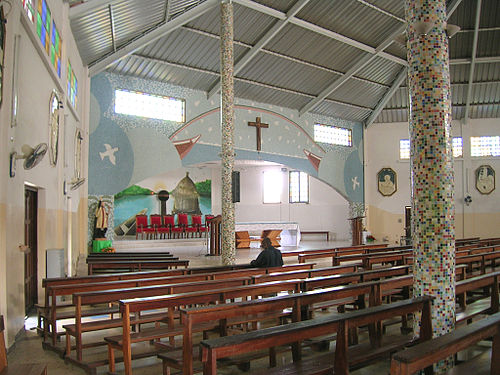Joal-Fadiouth | |
|---|---|
Town andcommune | |
| Coordinates:14°10′N16°50′W / 14.167°N 16.833°W /14.167; -16.833 | |
| Country |  Senegal Senegal |
| Region | Thiès Region |
| Department | M'Bour |
| Area | |
• Town andcommune | 17.34 km2 (6.70 sq mi) |
| Population (2023 census)[1] | |
• Town andcommune | 61,582 |
| • Density | 3,551/km2 (9,198/sq mi) |
| Time zone | UTC+0 (GMT) |
Joal-Fadiouth is a town and urban commune in theThiès Region at the end of thePetite Côte ofSenegal, south-east of Dakar.
Joal lies on the mainland, whileFadiouth, linked by abridge, lies on anisland ofclamshells, which are also used in localarchitecture andcrafts. The village has no motorised transport evidenced by the sign on entering. It has largeChristian andMuslim populations withcemeteries on another shell island. Another attraction isgranaries onstilts in the water. The population of the commune in 2013 was some 46,000.
While the origin of the village remains disputed, the establishment of theSerer in the area is assumed to have begun when the advance of theAlmoravids in the 11th century forced them to leave theSénégal River valley, occupying thePetite Côte and the region of theSine River. Another theory claims that Joal and Fadiouth have been founded by theGuelowar when they were expelled from the kingdom ofKaabu. Both of these theories draw on the frequency of certain surnames as evidence, indicating families' ethnic origins.
During thecolonial period, Joal became one of the largest trading posts in Western Senegal. By the late 16th century,Dutch andPortuguese traders were both established there, as well as further up the coast inSaly.[2] Until around 1635, a community ofPortuguese Jewish traders lived in the village. Protected by the local chief, they were allowed to openly profess their religion, to the annoyance of the Portuguese (Catholic) government.

The establishment of European posts in the region enabled penetration by missionaries as early as the 17th century. Theproselytisation however was met by strong resistance by the local population, delaying large-scale evangelising by the Europeans to the 19th century when Senegal became a French colony. In 1850, a mission was finally established in the village, the first priest was ordained there in 1885.
It was during that time that the passage ofEl Hadj Umar Tall was commemorated by building a mosque for his appraisal. The important architectural legacy recalling this memorable passing is in danger of deterioration.

Joal-Fadiouth was initially a canton, later on a county seat. It was elevated to a commune on 1 February 1966, with the process being completed by decree n° 72-82 on 3 February 1972 defining the borders of the commune.
Today, Joal-Fadiouth is a part of theM'bour Department, occupying the southernmost point of theThiès Region.
Bordering theAtlantic Ocean in the west, the commune incorporates therural community ofNguéniène in the north and the rural community ofPalmarin in the south.
Its mayors have been Jean Collin, Emmanuel Sobel Diouf, Paul Ndong and presently Boucar Diouf
Joal-Fadiouth occupies an intermediate point between theSahel Belt and the humidCasamance region.
Due to its position in an estuary, the greater part of the commune (3,021 hectares) is seasonally flooded.
The climate is typical of the Sahel with 3 to 4 months of winter from July to October and mild temperatures from November to April. The annual average temperature is 29 °C.

The estuary is at any time of the year populated by mangroves, it is pervaded bybolongs, arms of the sea common to the coast of Senegal, mixing salt-water with river water and sprinkled with little isles of sea shells populated bybaobabs andacacias.
The mangrove woods are populated by sea birds (sea gulls,woodcocks,pelicans,flamingos). Monkeys,ciconias andhyenas are also to be found there. This island has millions of sea shells, the local people use the shells to decorate their graves.

The most recent census of 2013 put the population at 45,903 people. The population is predominantly ofSerer origin. In a country with an overwhelming majority of Muslims, the inhabitants of the isle of Fadiouth are 90% Christian.

The main income of Joal is fishing (it is the largest fishing harbour of Senegal),agriculture andtourism.

Fadiouth has ahot semi-arid climate (BSh) with no rainfall from November to May and moderate to heavy rainfall from June to October.
| Climate data for Fadiouth | |||||||||||||
|---|---|---|---|---|---|---|---|---|---|---|---|---|---|
| Month | Jan | Feb | Mar | Apr | May | Jun | Jul | Aug | Sep | Oct | Nov | Dec | Year |
| Mean daily maximum °C (°F) | 31.4 (88.5) | 32.7 (90.9) | 33.9 (93.0) | 33.8 (92.8) | 33.6 (92.5) | 33.6 (92.5) | 32.1 (89.8) | 31.3 (88.3) | 31.9 (89.4) | 33.4 (92.1) | 34.0 (93.2) | 31.8 (89.2) | 32.8 (91.0) |
| Daily mean °C (°F) | 23.5 (74.3) | 24.6 (76.3) | 25.8 (78.4) | 26.3 (79.3) | 27.0 (80.6) | 28.3 (82.9) | 27.9 (82.2) | 27.3 (81.1) | 27.6 (81.7) | 28.0 (82.4) | 27.0 (80.6) | 24.4 (75.9) | 26.5 (79.6) |
| Mean daily minimum °C (°F) | 15.7 (60.3) | 16.5 (61.7) | 17.8 (64.0) | 18.9 (66.0) | 20.5 (68.9) | 23.0 (73.4) | 23.7 (74.7) | 23.4 (74.1) | 23.3 (73.9) | 22.7 (72.9) | 20.0 (68.0) | 17.0 (62.6) | 20.2 (68.4) |
| Average rainfall mm (inches) | 1 (0.0) | 0 (0) | 0 (0) | 0 (0) | 0 (0) | 32 (1.3) | 123 (4.8) | 258 (10.2) | 184 (7.2) | 44 (1.7) | 2 (0.1) | 1 (0.0) | 645 (25.3) |
| Source: Climate-Data.org[3] | |||||||||||||